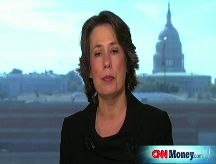Credit freeze: Signs of a thaw
Bank-to-bank lending rates dip for the second day in a row as lenders show more confidence. The easing comes a day after the government unveils its plan to buy equity in banks.
NEW YORK (CNNMoney.com) -- The credit markets continued to show signs of relief Wednesday, a day after the U.S. government announced plans to inject capital directly into banks by buying their stock.
The overnight bank-to-bank lending rate known as Libor slipped to 2.14% from 2.18%Tuesday, according to Bloomberg.com. The measure had been as high as 5.09% last Thursday.
Lower interbank lending rates signaled an increased willingness on the part of banks to lend to each other, which eventually translates into lower borrowing costs for consumers.
Frozen credit pipelines had stalled economies around the world, pushing lawmakers to make global coordinated efforts to increase liquidity and give banks the confidence to begin lending to each other again.
Lending rates: The 3-month Libor continued its descent Tuesday, ticking lower to 4.55% from 4.64% the previous day, according to Bloomberg.com. The measure remains at elevated levels. It had surged to 4.82% Friday - the highest since mid-December 2007. By comparison, it was only 2.82% a month ago.
Libor is a daily average of what 16 different banks charge other banks to lend money in London and is used to calculate adjustable rate mortgages. The higher the rate, the tougher it could be for homeowners to pay those mortgages.
For the week ended Oct. 10, the average interest rate for 30-year fixed rate mortgages jumped to 6.47% from 5.99% in the previous week, according to a report from the Mortgage Bankers Association released Wednesday.
However, mortgage rates are sitting at levels not that different from a year ago, when they averaged 6.4%, according to MBA.
Fixed mortgage rates typically track the yield on the 10-year note, so when those yields rise, mortgage rates follow.
"The yield on the 10-year Treasury note - the benchmark for 30-year fixed mortgage rate - moved up about 40 basis points (0.4%) over the course of the week," said Orawin Velz, MBA's associate vice president of economic forecasting, in a written statement.
Libor is also used to calculate other types of loans, including student and auto.
The dips signal some loosening of the tight credit hold, but there is still a long way to go before cash flows freely, said Kenneth Naehu, managing director and head of fixed income at Bel Air Investment Advisors.
Rumblings of risk aversion remain: Two market gauges show that investors continue to be wary.
For example, the "TED spread" edged up to 4.37%, after moving between 4.30% and 4.09% Tuesday.
The TED spread measures the difference between the 3-month Libor and the 3-month Treasury bill, and is a key indicator of risk. The higher the spread, the more unwilling investors are to take risks.
The spread was 1.04% just a little over a month ago and had reached a record high of 4.65% on Friday.
Another indicator, the Libor-OIS spread, rose to 3.41% from 3.39% Tuesday, after touching a record-high 3.67% Friday. The Libor-OIS spread measures how much cash is available for lending between banks, and is used for determining lending rates. The bigger the spread, the less cash is available for lending.
Treasurys: Government bond prices were higher Wednesday as investors looked for a short-term safe haven, although increased inflationary pressures weighed on gains.
The Labor Department's Producer Price Index showed that the core rate, which excludes volatile food and energy costs, rose by 0.4%. That was twice as high as analysts had expected.
"That was very bad on the broad front [and] indicates that inflation will at least for a little be worse than before," said Pierre Ellis, senior economist at Decision Economics.
That will keep downward pressure on longer-term bond prices because investors quickly become wary about tying up assets in long-term investments if there is a chance inflation will intensify.
The 30-year bond reversed course, rising to 105-5/32, while the yield dipped to 4.19% from 4.27%.
The benchmark 10-year note was up to 100-14/32, while its yield was 3.94%. Bond prices and yields move in opposite directions.
The 2-year note ticked up 16/32 to 100-27/32 and its yield dipped to 1.56% from 1.81%.
Also on Tuesday, the Treasury auctioned off more than $70 billion of debt in the form of 1-month bills and cash management bills, which are short-term securities offered as needed.
3-month bill: The yield on the 3-month Treasury bill is closely watched as an immediate reading on investor confidence. Investors and money-market funds shuffle funds into and out of the 3-month Treasury bill frequently, as they assess risk in the rest of the marketplace.
The yield on the 3-month bill fell to a low of 0.17% before climbing to 0.22% Wednesday. That compares with Tuesday's late-day yield of 0.27%.
"At the shorter maturity, the prices are reflecting great desire for security," said Ellis.
And Naehu added that investors are "parking money" until they see the successful implementation of the government's bailout.
After the stock market's 936-point rally on Monday, investors dumped Treasurys in favor of the more profitable equity markets. However, after watching Wall Street's more tepid performance Tuesday, with the Dow closing down 76 points, investors returned to the bond market.
Government debt is considered by investors to be among the safest assets. In times of uncertainty, demand for Treasurys increase, sending prices higher.
Fed moves: On Monday, the Federal Reserve announced it would provide unlimited dollars, on a short-term basis (84 day, one week, two week) to the Bank of England, the European Central Bank and the Swiss National Bank. On Tuesday, the Bank of Japan joined the program.
As those funds move through the system, the flow of U.S. dollars will help unclog the pipelines.
And on Tuesday, the government announced that the Treasury will buy up to $250 billion in senior preferred shares in a variety of banks, and so far, nine banks have agreed to have the government take a stake. In addition, the Federal Deposit Insurance Corp. will temporarily provide unlimited coverage for all non-interest-bearing accounts.
"The goal of these policy actions is to diminish the perceptions of risk by boosting the capital of banks and ensuring the funding of banks is going to be reasonably stable," said Ellis.
Despite a slew of historic and extraordinary moves, however, it could take a while for the economy to return to health. "It is a little premature to gauge success because they have just begun to start to implement" all of the plans that have been announced, said Naehu. "The market has a sort of wait-and-see feel to it," he said.
The broader questions that lenders have about the health of the economy are "not going to be answered by a plan being in place," added Naehu. Those uncertainties will finally "be answered by implementation and the effects that the implementation has on the credit markets." ![]()






